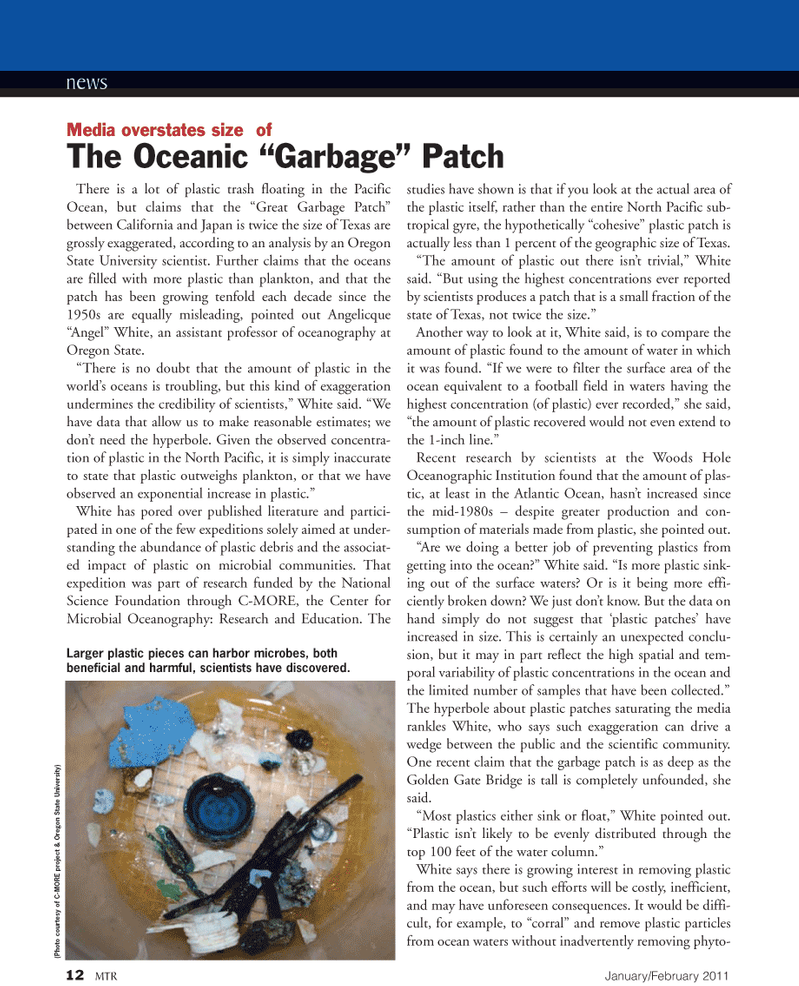
Page 12: of Marine Technology Magazine (January 2011)
Marine Salvage & Recovery
Read this page in Pdf, Flash or Html5 edition of January 2011 Marine Technology Magazine
12 MTR January/February 2011 news (Photo cour tesy of C-MORE pr oject & Or egon State University)
There is a lot of plastic trash floating in the Pacific
Ocean, but claims that the “Great Garbage Patch” between California and Japan is twice the size of Texas are grossly exaggerated, according to an analysis by an Oregon
State University scientist. Further claims that the oceans are filled with more plastic than plankton, and that the patch has been growing tenfold each decade since the 1950s are equally misleading, pointed out Angelicque “Angel” White, an assistant professor of oceanography at
Oregon State. “There is no doubt that the amount of plastic in the world’s oceans is troubling, but this kind of exaggeration undermines the credibility of scientists,” White said. “We have data that allow us to make reasonable estimates; we don’t need the hyperbole. Given the observed concentra- tion of plastic in the North Pacific, it is simply inaccurate to state that plastic outweighs plankton, or that we have observed an exponential increase in plastic.”
White has pored over published literature and partici- pated in one of the few expeditions solely aimed at under- standing the abundance of plastic debris and the associat- ed impact of plastic on microbial communities. That expedition was part of research funded by the National
Science Foundation through C-MORE, the Center for
Microbial Oceanography: Research and Education. The studies have shown is that if you look at the actual area of the plastic itself, rather than the entire North Pacific sub- tropical gyre, the hypothetically “cohesive” plastic patch is actually less than 1 percent of the geographic size of Texas. “The amount of plastic out there isn’t trivial,” White said. “But using the highest concentrations ever reported by scientists produces a patch that is a small fraction of the state of Texas, not twice the size.”
Another way to look at it, White said, is to compare the amount of plastic found to the amount of water in which it was found. “If we were to filter the surface area of the ocean equivalent to a football field in waters having the highest concentration (of plastic) ever recorded,” she said, “the amount of plastic recovered would not even extend to the 1-inch line.”
Recent research by scientists at the Woods Hole
Oceanographic Institution found that the amount of plas- tic, at least in the Atlantic Ocean, hasn’t increased since the mid-1980s – despite greater production and con- sumption of materials made from plastic, she pointed out. “Are we doing a better job of preventing plastics from getting into the ocean?” White said. “Is more plastic sink- ing out of the surface waters? Or is it being more effi- ciently broken down? We just don’t know. But the data on hand simply do not suggest that ‘plastic patches’ have increased in size. This is certainly an unexpected conclu- sion, but it may in part reflect the high spatial and tem- poral variability of plastic concentrations in the ocean and the limited number of samples that have been collected.”
The hyperbole about plastic patches saturating the media rankles White, who says such exaggeration can drive a wedge between the public and the scientific community.
One recent claim that the garbage patch is as deep as the
Golden Gate Bridge is tall is completely unfounded, she said. “Most plastics either sink or float,” White pointed out. “Plastic isn’t likely to be evenly distributed through the top 100 feet of the water column.”
White says there is growing interest in removing plastic from the ocean, but such efforts will be costly, inefficient, and may have unforeseen consequences. It would be diffi- cult, for example, to “corral” and remove plastic particles from ocean waters without inadvertently removing phyto-
Media overstates size of
The Oceanic “Garbage” Patch
Larger plastic pieces can harbor microbes, both beneficial and harmful, scientists have discovered.

 11
11

 13
13
